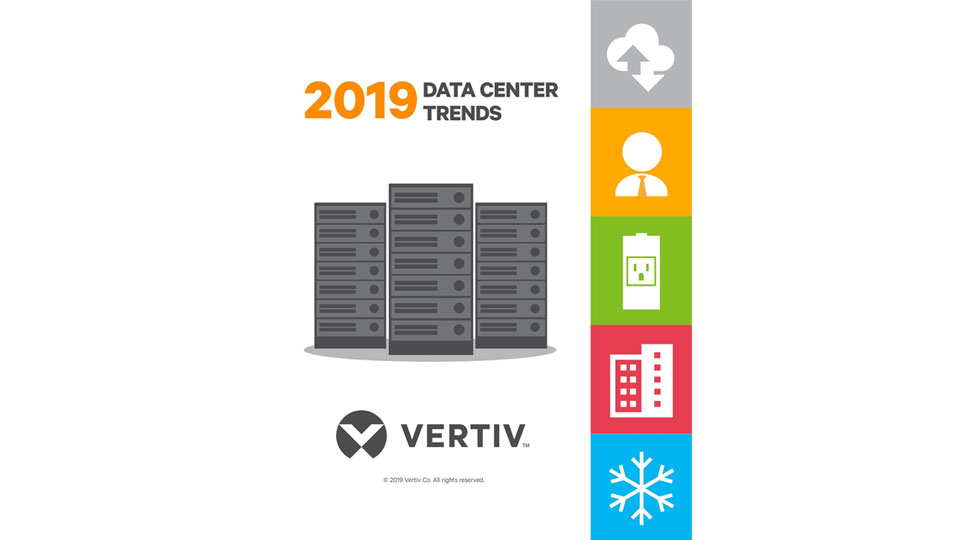
Vertiv Identifies Top Five 2019 Data Center Trends
The edge of the network continues to be the epicenter of innovation in the data center space as the calendar turns to 2019, with activity focusing on increased intelligence designed to simplify operations, enable remote management and service, and bridge a widening skills gap. This increasing sophistication of the edge is among the data center trends to watch in 2019 as identified by Vertiv experts from around the globe.
“Today’s edge plays a critical role in data center and network operation and in the delivery of important consumer services,” said Vertiv CEO Rob Johnson. “This is a dramatic and fundamental change to the way we think about computing and data management. It should come as no surprise that activity in the data center space in 2019 will be focused squarely on innovation at the edge.”
1. Simplifying the Edge: A smarter, simpler, more self-sufficient edge of the network is converging with broader industry and consumer trends, including the Internet of Things (IoT) and the looming rollout of 5G networks, to drive powerful, low-latency computing closer to the end-user.
For many businesses, the edge has become the most mission critical part of their digital ecosystem. Intelligent infrastructure systems with machine learning capabilities working in tandem with cloud-based analytics are fundamentally changing the way we think about edge computing and edge services. The result will be a more robust, efficient edge of the network with enhanced visibility and self-healing capabilities requiring limited active management.
“In Asia, the edge is no longer just a buzzword but a reality and many organizations are realizing the value of having a strong core to edge ecosystem to support high compute and low latency demands,” said Anand Sanghi, president, Asia and India, Vertiv. “As the edge becomes a critical and strategic part for many organizations, it’s no longer about simply having availability, but protecting and optimizing the edge with the right infrastructure to deliver the best customer experience.”
2. Workforce Revolution: A workforce aging into retirement and training programs lagging behind the data center and edge evolution are creating staffing challenges for data centers around the globe. This will trigger parallel actions in 2019. First, organizations will begin to change the way they hire data center personnel, moving away from traditional training programs toward more agile, job-specific instruction with an eye toward the edge. More training will happen in-house. And second, businesses will turn to intelligent systems and machine learning to simplify operations, preserve institutional knowledge, and enable more predictive and efficient service and maintenance.
3. Smarter, More Efficient UPS Systems: New battery alternatives will present opportunities for the broad adoption of UPS systems capable of more elegant interactions with the grid. In the short term, this will manifest in load management and peak shaving features. Eventually, we will see organizations using some of the stored energy in their UPS systems to help the utility operate the electric grid. The static storage of all of that energy has long been seen as a revenue-generator waiting to happen. We are moving closer to mainstream applications.
4. Pursuing Normalization: The data center, even in the age of modular and prefabricated design, remains far too complex to expect full-fledged standardization of equipment. However, there is interest on two fronts: standardization of equipment components and normalization across data center builds. The latter is manifesting in the use of consistent architectures and equipment types, with regional differences, to keep systems simple and costs down. In both cases, the goal is to reduce equipment costs, shorten delivery and deployment timelines, and simplify service and maintenance.
5. High-Power Processors and Advanced Cooling: As processor utilization rates increase to run advanced applications such as facial recognition or advanced data analytics, high-power processors create a need for innovative approaches to thermal management. Direct liquid cooling at the chip – meaning the processor or other components are partially or fully immersed in a liquid for heat dissipation – is becoming a viable solution. Although most commonly used in high-performance computing configurations, the benefits – including better server performance, improved efficacy in high densities, and reduced cooling costs – justify additional consideration. Another area of innovation in thermal management is extreme water-free cooling, which is an increasingly popular alternative to traditional chilled water.
About Vertiv
Vertiv brings together hardware, software, analytics and ongoing services to ensure its customers’ vital applications run continuously, perform optimally and grow with their business needs. Vertiv solves the most important challenges facing today’s data centers, communication networks and commercial and industrial facilities with a portfolio of power, cooling and IT infrastructure solutions and services that extends from the cloud to the edge of the network. Headquartered in Columbus, Ohio, USA, Vertiv employs around 20,000 people and does business in more than 130 countries.






